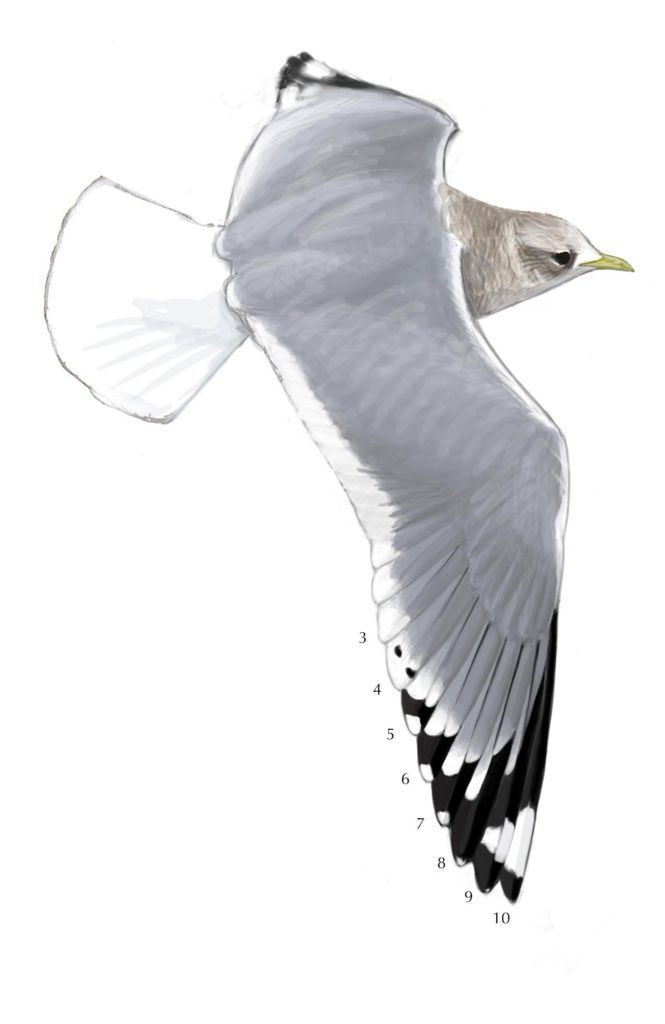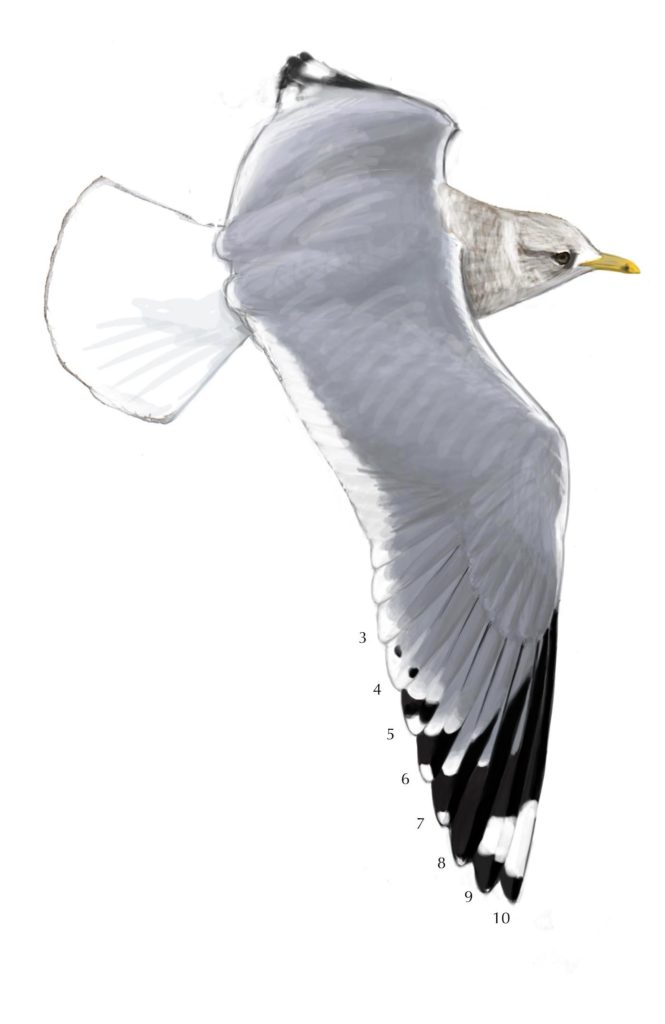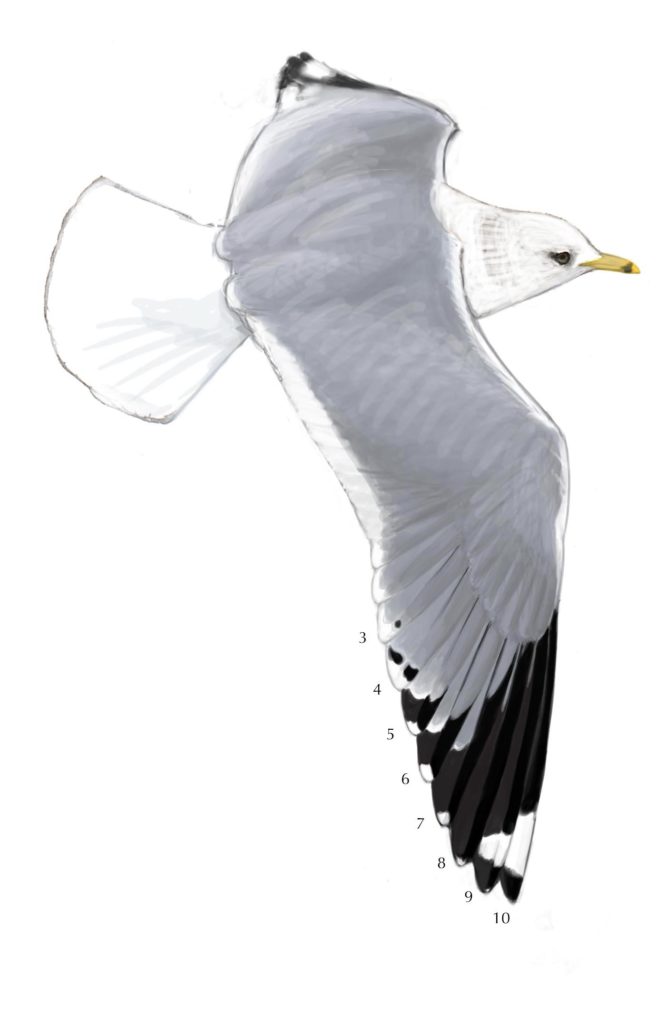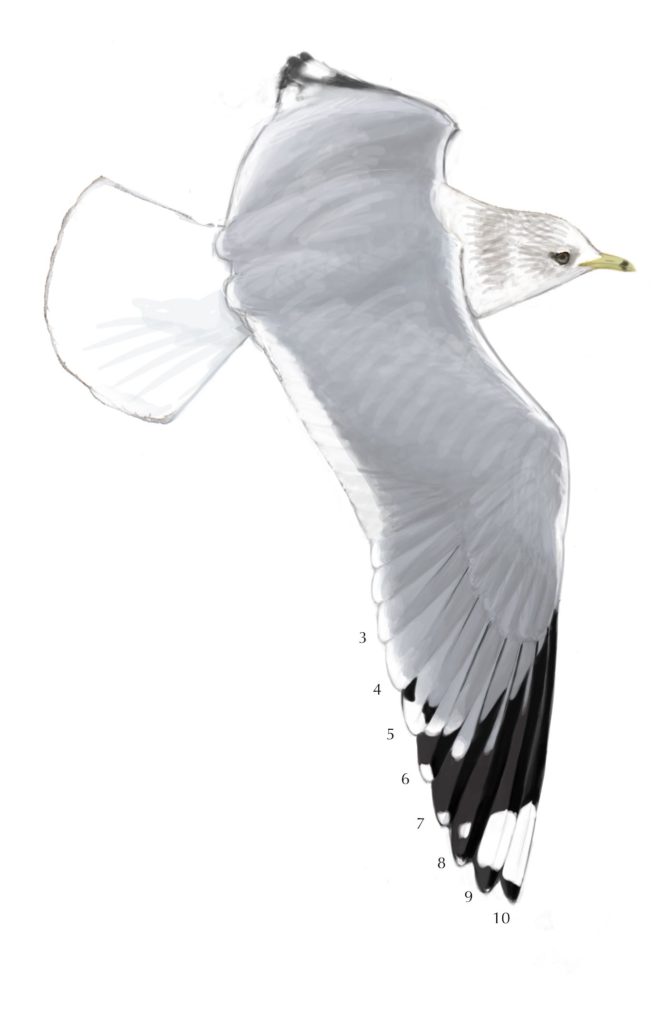For North American birders the most consequential change in the 2021 AOS Checklist supplement is the split of Mew Gull into two species – Short-billed Gull and Common Gull. For most birders this simply means changing the name of the species on your list from Mew Gull to Short-billed Gull. The North American population, common along the Pacific coast, is now known as Short-billed Gull. Eurasian populations are now classified as a separate species, Common Gull, and birds from these populations reach North America as rare but regular visitors. These are gulls, so you can be sure their identification is complicated, and to make matters worse the Common Gulls that reach North America arrive from both east and west and represent two different subspecies – Kamchatka and European.
I’ve put together a set of illustrations of winter adults of the species and subspecies, which will soon be added to my app. Immatures are even more distinctive, and I’ll be working on illustrations of those as well.
Luckily a very detailed and thorough review of the identification of these taxa was published recently by Peter Adriaens and Chris Gibbins, and I have relied heavily on that information in preparing these illustrations and notes. Disclaimer: This is a simplified summary of a very complex challenge. There is a lot of variation and a lot of overlap, and you should not identify one of these gulls unless multiple features align with that identification. Far more detail is in the paper by Adriaens and Gibbins, which is essential reading for anyone who hopes to tackle this challenge.
Short-billed Gull – winter adult

Short-billed Gull
This is the North American breeding species common along the Pacific coast, but very rare in the east, and in the far northeast US and Canada it is less frequent than Common Gull.
In general this species has less black toward the leading edge of the wingtip than Common Gull does, as well as more white in the tips of the primaries. The overall effect is of a fairly evenly forked V-shape of black around the wingtip, in contrast to the more solid black triangle of Common Gull.
- long gray tongue on inner web of p9 (more than on Common Gull)
- black on outer web of p9 does not reach primary coverts (less black than on Common Gull)
- long gray tongue with broad white tip on inner web of p8, nearly reaching the white mirror of p9 (more gray and white than on Common Gull)
- black on outer web of p8 covers about half the length of the feather or less (less than on Common Gull)
- black on outer web of p7 usually covers less than half of the feather (less than on Common Gull)
- usually a complete black band on p5, and some black on p4 (more black than on European Common Gull)
- white tips on inner primaries (like p3) usually relatively broad, similar to the secondaries (more white than on Common Gull)
- head and neck typically heavily marked with blurry smudges of gray-brown, often suggesting a barred pattern (more heavily marked than Common Gull, and less distinctly streaked)
Common Gull – Kamchatka subspecies winter adult

Kamchatka Common Gull
This subspecies of Common Gull nests in eastern Siberia and Kamchatka. It is a rare but regular visitor to far western Alaska around the Bering Straits, and somewhat surprisingly has turned up repeatedly in recent years in the northeastern US and eastern Canada with well documented records in Connecticut, Massachusetts, Nova Scotia, Newfoundland, and more. Clearly it should be watched for elsewhere across the continent. There are no accepted records on the Pacific coast south of Alaska, perhaps not due to a real absence but instead reflecting the difficulty of picking one out among the numerous Short-billed Gulls.
The largest subspecies and relatively dark above, but otherwise intermediate in many ways between Short-billed Gull and Common Gull.
- medium length gray tongue on p9 (more gray than other Common Gulls, less than Short-billed Gull)
- black on outer web of p9 often reaches primary coverts (more black than Short-billed Gull, similar to other Common Gulls)
- medium length gray tongue on p8, with little or no white band at tip (more gray and white than other Common Gulls, more black and less gray and white than Short-billed Gull)
- black on outer web of p8 covers most of the length of the feather (more black than Short-billed Gull, slightly less than other Common Gulls)
- black on outer web of p7 covers about half length of feather (more black than Short-billed Gull, slightly less than other Common Gulls)
- usually a complete black band on p5, and some black on p4 (like Short-billed, more black than on European Common Gull)
- white tips on inner primaries (like p3) usually relatively narrow, distinctly narrower than on secondaries (less white than on Short-billed Gull, similar to other Common Gulls)
- head and neck typically fairly heavily marked with smudgy streaks (more heavily marked than other Common Gulls, averages a little less heavily marked and more streaked than Short-billed Gull)
Common Gull – Russian subspecies winter adult

Russian Common Gull
The Russian subspecies of Common Gull, nesting from eastern Europe to eastern Siberia, has not been reported in North America, but it intergrades with both European and Kamchatka subspecies in the western and eastern parts of its range, and one banded Common Gull found in Newfoundland originated in the intergrade zone in eastern Europe. It’s worth knowing the features of this subspecies.
The most black in the wingtips of any of these taxa, and the whitest head in winter.
- essentially no gray tongue on p9 (more black than any other taxa)
- black on outer web of p9 often reaches primary coverts (more black than Short-billed Gull, and other Common Gulls)
- short gray tongue on p8, with no white band at tip (more black than any other taxa)
- black on outer web of p8 covers entire feather feather (more black than any other taxa)
- black on outer web of p7 covers most of feather (more black than any other taxa)
- almost always a complete black band on p5, often extensive black on p4 (more black than any other taxa and much more than on European Common Gull)
- white tips on inner primaries (like p3) usually relatively narrow, distinctly narrower than on secondaries (less white than on Short-billed Gull, similar to other Common Gulls)
- head and neck typically whitish with a band of faint streaks around the back of the neck (less heavily marked than any other taxa)
Common Gull – European subspecies winter adult

European Common Gull
This subspecies of Common Gull is a familiar bird in city parks and shorelines around Europe. It is a more or less regular winter visitor to Newfoundland, with nearly annual records in winter south and east to Massachusetts.
Relatively small, palest on the back, and with reduced black along the trailing edge of the wingtip
- short gray tongue on p9 (a medium amount among Common Gulls, less than Short-billed Gull)
- black on outer web of p9 often reaches primary coverts (more black than Short-billed Gull, similar to other Common Gulls)
- medium length gray tongue on p8, with no white band at tip (medium among Common Gulls, more black and less gray and white than Short-billed Gull)
- black on outer web of p8 covers most of the length of the feather (more black than Short-billed Gull, medium among Common Gulls)
- black on outer web of p7 covers at least half length of feather (more black than Short-billed Gull, medium among Common Gulls)
- usually an incomplete black band on p5, and almost never black on p4 (less black than any other taxa)
- white tips on inner primaries (like p3) usually relatively narrow, distinctly narrower than on secondaries (less white than on Short-billed Gull, similar to other Common Gulls)
- head and neck typically with distinct fine streaks mainly on crown, cheeks, and hindneck (medium among Common Gulls, averages less heavily marked and much more distinctly streaked than Short-billed Gull)
More notes on identification
Status – Approaching the identification of any “Mew Gull” it is helpful to have some expectations as a starting point, but this varies by region. Along the Pacific coast and east to the Rocky Mountain states and provinces Short-billed Gull is the expected species, and claiming a Common Gull there will require lots of documentation. At the other side of the continent in Newfoundland Common Gull (European subspecies) is the expected taxon, with one record of the Kamchatka subspecies and no records of Short-billed Gull. In southern New England Common Gull records still outnumber Short-billed Gull, but in recent years the Kamchatka subspecies of Common Gull has been about as frequent as the European. Farther west and south Short-billed Gull becomes the expected taxon. Common Gull (the species, not necessarily the European subspecies) has been reported west to Ontario and south to North Carolina. But all of those Kamchatka Common Gulls in New England are presumably coming from the west, and it’s plausible that they are dispersing across the continent in the same way that Slaty-backed Gulls do. A careful review of extralimital “Mew Gull” records from across the continent could be very enlightening.
Wingtip pattern – Besides being variable, with much overlap between species and subspecies, the details of wingtip pattern are extremely difficult to confirm in field observations. The overall appearance of the wingtip pattern can change dramatically as the wing spreads and folds. Many critical details (such as the extent of gray on the inner webs of the feathers) can be hidden by overlapping feathers during normal flight, and are only visible when the wing is fully spread. Identifying these species and subspecies therefore is essentially impossible without sharp photographs showing the fully spread wing.
A word of caution about subadults – Second year individuals of these species often look very much like adults, but tend to have a little more black in the wingtips. Before getting too far into the identification process using details of wingtip pattern, it’s important to look for evidence of immaturity – dark markings in the primary coverts, tail, etc. If a bird shows any signs of being less than a full adult, the details of wingtip pattern will be less reliable.
Size – There is some average regional variation in size. Short-billed Gull is relatively small and has a small bill (appropriately). The Kamchatka subspecies of Common Gull is relatively large and long-billed, and can appear more like a “big” gull. Other subspecies of Common Gull are closer to Short-billed Gull in size and proportions, and there is extensive variation in all four taxa. Exceptionally large Short-billed Gulls and exceptionally small Kamchatka Gulls do occur. Size might be useful as a supporting clue in the identification, but should not be given too much emphasis.
Mantle color – palest on European Common Gull (close to Ring-billed Gull), darkest on Kamchatka Common Gull. Short-billed Gull is also quite dark gray on average, usually distinctly darker than Ring-billed Gull. But mantle color is variable and not particularly reliable for separating these taxa.
Winter head markings – There are average differences in the pattern and extent of dark markings on the head and neck, described and illustrated above. Like other features this is quite variable and requires some experience to understand the differences and the variation. Use with caution.
Bill color – Slight differences in average color and pattern might be useful as supporting clues. Short-billed Gull usually has a drab greenish bill in winter with at most a faint dusky ring. Common Gull often has a more distinct blackish ring on the bill, and Kamchatka and Russian subspecies apparently often retain brighter yellow bill color through the winter. All taxa have an unmarked yellow bill in summer, and the timing of the color change in late winter or spring is presumably quite variable, complicating the use of this as a field mark.


Where are the decisions on this year’s proposals available?
Hi David,
You need to get DNAs from these Mew gulls and Common gulls, to see if they are really two species.
Plus photos / your future drawings of 1 1/2-month old Mew gull and 1 1/2-month-old Common gulls in juvenile plumages.
Yours Sincerely
Clinton Care.
I had forgotten about your lovely guides. A newsletter I signed up for featured you, and I wondered if you knew. Here’s the page with the link (she lauds your bird leg temperature paragraph), https://www.enchantingmarketing.com/how-to-write-simply
We will include you in our book suggestions for parents in the upcoming Natural History curriculum.
Delightful to read about your illustrations. I find the details in your illustrations very useful when I try to distinguish between similar species.
DNA studies on all “Common” gulls was already published quite some time ago.
Kamchatka Common and the heinei ssp of common vary hardly, but your Mew Gull (the one breeding on your west-coast, differs very much from the other three.
this, in part, was one of the reasons for the proposed split.
There is ofcourse a 4th Common Gull, the smallest of all the Dutch Common Gull Larus canus minor (type location Rotterdam, The Netherlands) occupying roughly the same area in NW Europe as the Dutch Herring Gull Larus argentatus argenteus (type location Texel,The Netherlands).
I took photos of a bird this morning that very much appears to be a short billed gull. But it was located in Kure Beach, NC…southeast corner of the state. Info I read about the common gull from Europe indicates it is unlikely to be this far south on east coast. Is there someone I can submit a couple photos to.
Hi John
Did you ever get confirmation? I saw a possible Short-billed in Ocean City, MD.yesterday.
Hi Kim – congrats on your intersting find yesterday! I have no contact info for you so I’m glad you posted here; now I can ask you about the bird you saw! I looked at your pics as best I can, do you have any others with better resolution of the upper primaries? If not, I’m no expert (!), but it seems there is no way to seperate Common from Short-billed Gull based on the images in the eBird report.
Also, a request for further info, what happened to it – did it fly away/what direction?
David, wonderful coverage and illustrations about this tough group of gulls. Thanks for taking the time to share your knowledge and skills with us, and for incorporating Peter’s comprehensive paper into your notes and illustrations
I have a photo of a gull that I first thought was a B-l kittiwake, but in my effort to rule in/out I stumbled across your post here and now wonder if it was a Common gull subsp. It was seen this past week at Hampton Beach, NH. Might you be interested in seeing the photo? It’s a fairly good one of the bird in flight as seen from underneath.